Louise Chéruit: Timeless Parisian Couture, Yachting Style & Ocean Travel Elegance (1905–1930)
📌 Explore the elegant and influential world of Louise Chéruit, Parisian fashion icon whose couture defined ocean travel chic. Ideal for students, genealogists, and fashion historians.
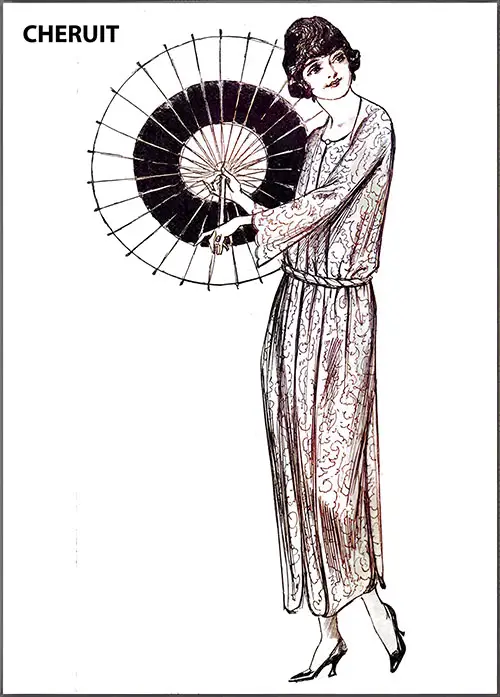
Under the influence of a Persian printed crêpe, Chéruit loops up the panels of a straight chemise dress into a semblance of a harem hem. Chéruit has a way of dealing with the narrow lines that keeps them from appearing scanty or constrained. The Delineator, June 1919. GGA Image ID # 1a3c132db6
🎩 Review & Summary: The Timeless Elegance of Louise Chéruit – Fashion at Sea and Ashore 🌊👗
The GG Archives' curated exploration of Louise Chéruit, one of the most significant Parisian couturières of the early 20th century, offers a richly layered look into the evolving silhouette of elite women—both in the salon and aboard transatlantic steamers. This extensive resource is ideal for teachers, students, genealogists, and fashion historians, especially those exploring the intersection of couture and ocean travel culture from the Edwardian through early Art Deco periods.
Chéruit shows an extensive and brilliant collection—consistent in that the same is remarkably clear, the good line is preserved throughout, and very varied as to stuff, colors, and trimmings.
Contrary to all rules, I will begin with the large exhibit of fur wraps, coats, and capes, the first outnumbering the second. Ermine, sable, mink, kolinsky, and Mole garments all have high, loose collars and sleeves starting from the waist.
Repeated several times, Broadtail is once fringed and collared in monkey; another time, it has a ruched black satin collar and plain silk hem. A three-quarter gazelle coat's collar is tied by a ribbon imitating snakeskin.
Capes are not very long nor voluminous; one is edged all around in gray goat. A blue and yellow plaid costume has a cape, pleated in the back only; a large square of skunk is placed at the top, which covers the shoulders and forms the collar.
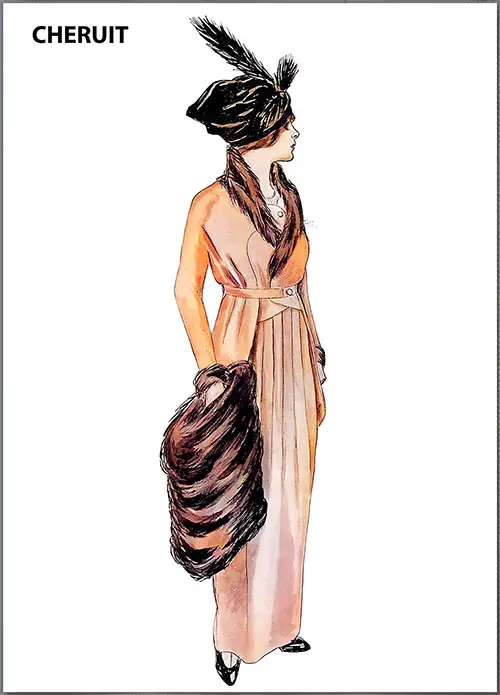
The Fulness in the Skirt of This Suit of Warm Brown Duvetyn by Cheruit Is Obtained From the Four Narrow Box-Plaits in the Front, Stitched to Knee Depth. The Jacket Introduces the Godet Plaits and Extends to About Eight Inches Below the Hips. A Suggestion of the Waistcoat Is Given to the Front of the Jacket by the Cut, and a Collar and Cuffs of Skunk Add the Finishing Touches. Harper's Bazar, October 1913, p. 52. | GGA Image ID # 1cc123f30a
A delightfully unique trimming on a white blanket cloth coat features a massive embroidery from hips to the hem. This embroidery, a crisscross pattern of ermine tails, is a sight to behold, adding a touch of intrigue to the design. A second, equally intriguing white satin coat is covered in the same design, this time done in alternately plain and pleated white ribbon.
A shortish coat of spotless white rabbit is adorned with a shirred white satin collar, tied with black satin. The effect is not just unforeseen, but also remarkably chic, inspiring new ideas for fashion enthusiasts.
The general silhouette at Cheruit's is loose and straight (though by no means narrow), applied to tailor-made, gives skirts shirred all around but not voluminous and a little longer than usual.
The average coat is three-quarters, with a big, loose reverse that falls open in a shawl fashion and low waists. The material embroidered on the belt accentuates this fact, and the sides of the basques may be gathered.
The stuffs are blanket, corduroy, velours de laine, and a new material, Popelabure circudrée, which is a unique blend of sacking with a beige center framed in a broad black selvage, creating a striking contrast.
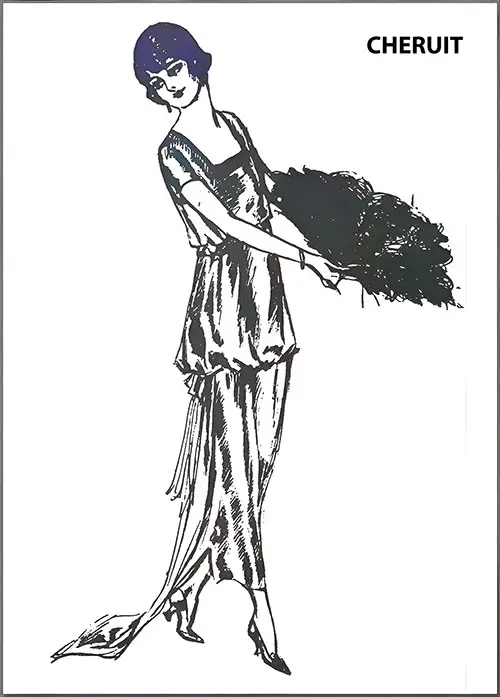
In a Chéruit Gown of Gold Cloth with Black Chiffon at the Neck, the Looped-up Drapery Gives the Effect of a Short Tunic, and the Plaited Train at the Side is Faced with Black. The Delineator, March 1919. GGA Image ID # 1a3c46103f
The leading colors are greens, mole, mouse, elephant, and nègre. A three-quarter suit of bottle-green velours has pleated sides to the basques and a gazelle's scarf collar.
A bright blue cape costume attracted my attention. The cape, relatively short, edged with a fringe of monkey, is worn with a plain dress merely trimmed by a low, rolled, broad belt of the material at the hips. The dresses have low belts, giving a more decidedly than ever long waist.
The best stuff is duvetyn, a fine melton, and a sort of thin cloth, Kashavella, in beige, peach, orange, Negre, réseda, arsenic, and eucalyptus.
Many dresses may be classed apart as having no trimming, but the clever handling of the stuff itself provides that.
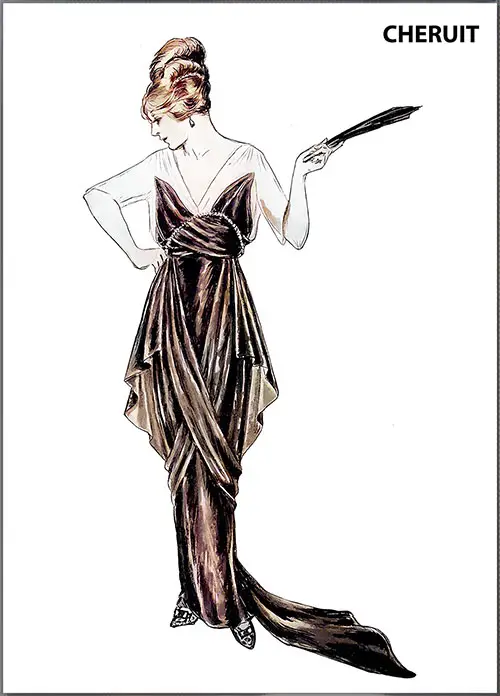
A Curious Draping Makes Cheruit's Evening Gown of Purple Velvet Interesting. The Bodice Forms Two Pointed Draped Loops of the Velvet Crossing in the Front, Narrowing to a Belt at the Sides and Disappearing Under a Wide Square Plastron of the Velvet, Which Begins High Across the Shoulders. The Plaited Panniers Accomplish the Fulness at the Sides, and There Is a Long Pointed Train. Pink Tulle Veils the Upper Shoulders and Forms the Elbow Sleeves, and a Band of Crystal Beads Curves Across the Front, Meeting in the Back a Large, Square Buckle of the Beads. Harper's Bazar, October 1913, p. 52. | GGA Image ID # 1cc13f6dd6
For instance, an orange is guiltless of adornment except for the collar; it is high at the back, and in front, two broad streamers of unequal length are edged with black satin. Another example is an oversized shawl collar opening to the waist over a muslin guimpe.
There are no coat dresses, and the gowns must be sufficiently tailored. Sleeves are extensive; enormously wide ones are cut into bands or sections of different colored materials; others form part of a shawl back coming over the front; wide sleeves have big rings of fur at intervals down the arms. Collars are semi-high, often a loosely rolled hand around the neck.
Among the various tendencies, we have the flat apron movement illustrated in arsenic-green melton, the apron from knee to hem adorned by three rows of finely pleated ruffles: dresses draped from hip to hip in flat wrinkles and buttoned to one side.
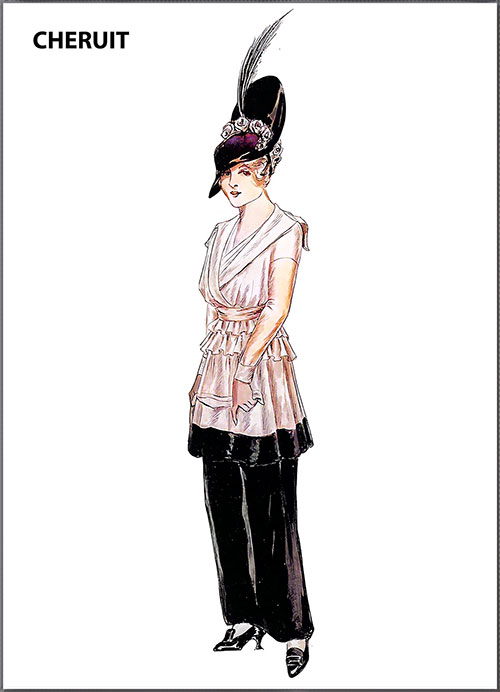
The Apron Front, Which Cheruit Is Featuring, Is Shown in the Débutante's Frock of Soft White Taffeta Combined With Black Velvet. Straight Pieces of the Taffeta Are Plaited Into the Belt in the Front. A Wide Band of the Velvet Edges the Plaited Tunic, and the Underskirt Is Likewise of the Velvet. There Is a Girlish Simplicity in the Bodice With the Fichu Effect in the Front and the Square Collar in the Back Finished With a Slightly Gathered Ruffle. Harper's Bazar, October 1913, p. 52. | GGA Image ID # 1cc1b1fa6b
A gray crêpe dress has detached loops of unequal lengths edged with squirrel turned over and under a wide low belt. A black crêpe de Chine frock with pleated sleeves and a rolled collar has a wide detached front panel embroidered in delicate red ribbon. The dress is often most prolonged at the sides.
The favorites are favorites for ribbon trimmings, pleated or plain, insignificant, bold patterns. Wooden beads stripe the sides of a brown satin gown; thin beige wool embroidery on a black net makes blurred floating panels on black velvet.
Cut-out applications of velvet leaves are to be found on a reddish-brown jersey. An orange duvetyn has a novel embroidery in the way of different colored woolen blobs sewn onto it in a small design.
For the evening, materials are light in tone, including yellow, coffee, nasturtium, réseda, and white. There is no heavy, rich metallic stuff: moiré, charmeuse, velvet, and ottoman make up the bulk of the collection.
The neckline is always round, more prominent at the back; the trains are very often the ends of the sash and, as such, long and slender.
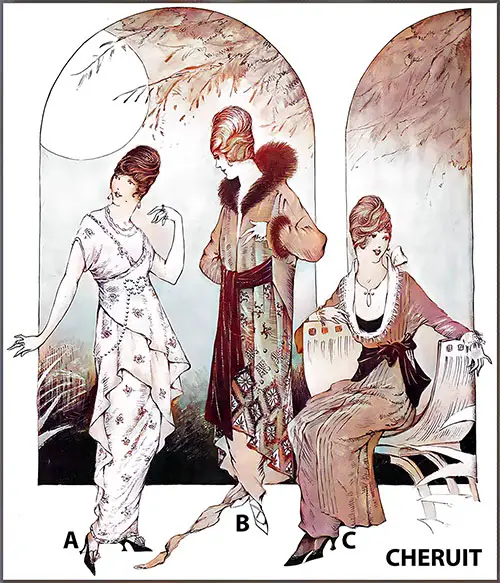
Chéruit's Original Yet Wearable Models. Harper's Bazar, May 1914, p. 48. | GGA Image ID # 1cc1b6703c
Chéruit's Original Yet Wearable Models
(A) No one can deny that Chéruit is the master of the subtle art of drapery, and she accomplishes her results without sacrificing the line. On her skill in this challenging achievement rests the cachet of the evening frock in deep marine blue taffeta embroidered in varicolored flowers. The long, full, gathered tunic falls in delightful billowy folds at either side of the sheath-like foundation of the skirt, which is edged around the bottom with a band of silver embroidery. In the draping of the corsage, Chéruit accents the Greek note and produces the long lines that make her models so wearable. These long lines were considered when she hung the string of pearls, fashioned in silk, from the twisted motif in front to a similar one in the back.
(B) Almost all of Chéruit's summer evening wraps are trimmed with fur. This long cloak of Empire green taffeta has a high silk collar edged with a generous band of skunk. The rich gold embroidery makes the garment's lower part very handsome. The cut of the cloak is characteristic; the upper part is loosely fitted, the fulness falling from shoulder pieces, and a wide belt or sash runs from each side across the front. The lower section consists of a full circular flounce, flaring out at the sides and sloping from a bit below the knees in the front to the bottom of the skirt in the back. The sash is loosely knotted in the front, with throw-over ends reaching the cloak's bottom.
(C) Chéruit changes a complete silhouette by arranging the fullness between the knee and ankle. This spring, she developed the long tunics she had introduced tentatively last fall. This full, plaited apron tunic reaches from the standard belt line to within eight or ten inches from the bottom of the tight, scant underskirt. It should be noted that these underskirts are very short, barely ankle-length, and peek out from beneath the full tunics like stiff cuffs. Even the blouse of this navy blue serge frock is plaited, and a clever bit of color is introduced into the black and yellow fringe outlining the white satin collar. In the arrangement of the ribbon belt, Chéruit is, again, original and practical.
Correct Clothes and Colors to Wear Aboard Ship
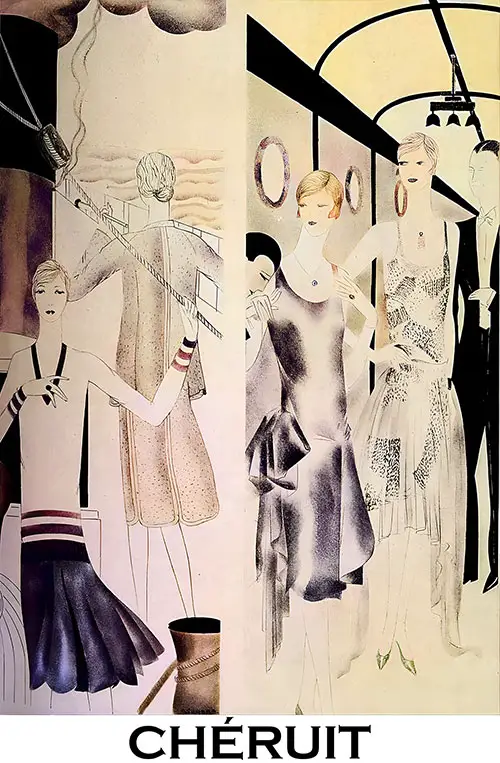
Clothes and Colors for Wearing Aboard Ship by Chéruit. Fairchild's International Magazine, August 1928. | GGA Image ID # 217bf24f51
Yachting is the sport of fashionable people", declared a leading couturier in Paris nearly a year ago. He went on to say that French society had recently discovered the delights of beach and sea life and that, as a consequence, clothes for watery pastimes were bound to undergo tremendous development.
Haute couture collections from the last season or two confirm this creator's judgment. We are beginning to demand clothes designed to withstand salt spray and ocean breezes, and practical knowledge may be helpful.
Madame Virginie Heriot is the supreme yachtswoman of France, and her fame has passed the frontiers of her own country. In her pretty yacht L'Ailée, she has done more than 20,000 miles, living entirely on board and weathering some rough gales in the Bay of Biscay and off the coast of Spain.
Last year, this brave sailor won back the Coupe de la Ville de Paris, which the British had held for several years. She competes this summer in the Olympics and September for the King of Spain's gold cup at St. Sebastian. At the proposal of the Minister of the Marine, Madame Hériot was promoted last January to the grade of Chevalier of the Legion of Honor; two months later, she received from the Académie des Sports the Grande Médaille d'Or for women's sports.
Madame Heriot's fashion choices testify to her belief that femininity and athleticism can coexist harmoniously. Her elegant and practical wardrobe reflects her dynamic personality, inspiring women to embrace their femininity without compromising their active lifestyle.
Madame Heriot's footwear choices perfectly exemplify her practical yet stylish approach to fashion. While her brown hair is cut in a sleek bob, her feet are always shod in the latest Parisian styles.
She is often found at the wheel of her yacht, even wearing high-heeled shoes. However, she opts for Argence sandals made to her specifications for more practical use aboard ship. These white suède sandals with red rubber soles are fashionable and designed to provide the necessary grip on the deck.
For stormy weather, the beret is naturally a favorite headgear. Still, Reboux makes for her the slight, soft felt characteristic of the house, cut to follow the natural outlines of the head, with small brims that defy the breezes. It is from Chéruit that Madame Heriot's costumes come.
When sailing, the knitted woolen jumper, with silk crepe or light woolen skirt, is given preference as most suitable. Every skirt is pleated or flared to provide freedom of movement. Usually, each tricot is matched by several skirts, as sea air is so quick to undo pleatings and crush light silks.
In all of her costumes, Madame Hériot is partisan of the silhouette, which follows the natural lines of the figure. In colors, she has decided preferences: blue and white. Both choices are logical; blue has always been a maritime color, and the fact that Madame Hériot is blue-eyed makes it especially apparent to her.
For daytime, she wears navy or slightly lighter, brighter blue; the deep shade we call midnight is a favorite for the evening. But no matter what color one's eyes, Madame Hériot holds white as pre-eminently desirable for the yachtswoman because it effectively sets off a skin bronzed by sea air and sunlight. For the evening, she varies white by silver.
Some of Madame Hériot's thoroughly feminine preferences in clothes are illustrated in the Chéruit models she chose, which are sketched above. The first sports model has a hand-knitted white sweater striped in tones of blue, with a gracefully scalloped navy crêpe de chine skirt of practical width. The original model was bifurcated, but Madame Heriot preferred it without the division.
The coat next to it, part of an ensemble, is in blue wool crêpe with a distinctly soft line. For evening, one of Madame Heriot's choices is a lacquered satin of midnight blue draped and caught into a bow on the hip. Another is a pale chiffon of uneven hemline, pailletted in metal sprays.
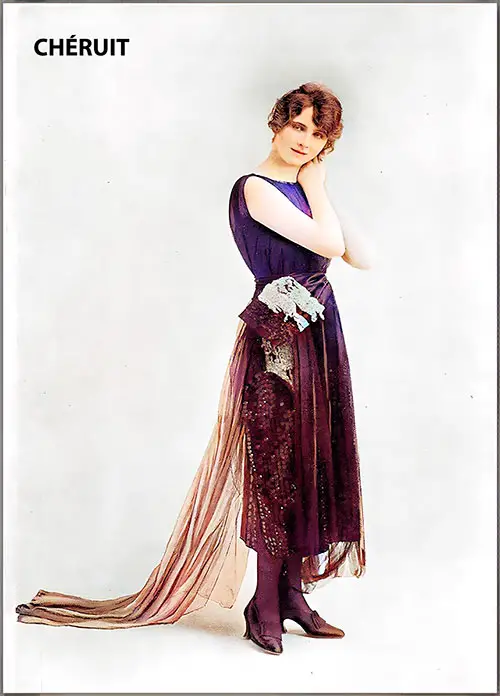
Evening Dress by Chéruit. Photo by Eméra. Les Modes, Issue 185, June 1919, p. 15. | GGA Image ID # 1cdb895ca1
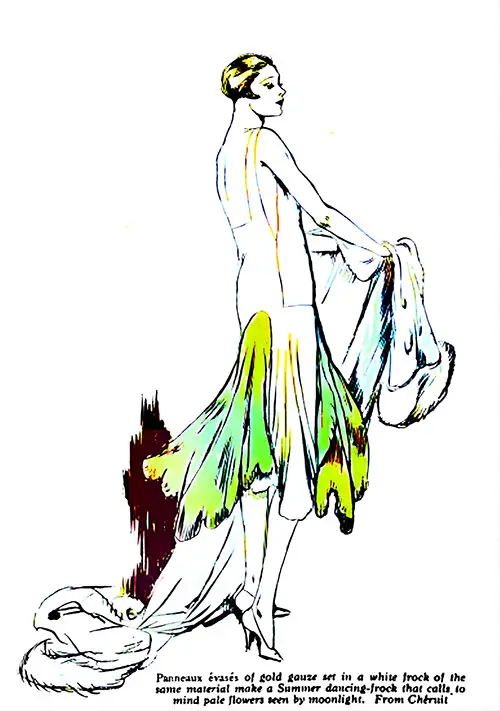
Panneaux Évasés of Gold Gauze Set In a White Frock of the Same Material From Chéruit Make a Summer Dancing Frock That Calls to Mind Pale Flowers Seen by Moonlight. The Delineator, August 1926. | GGA Image ID # 217be60646
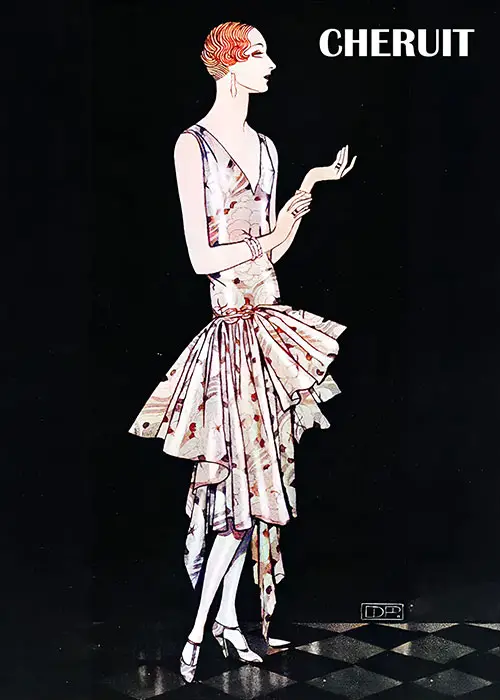
Chéruit Model From Thurn. On a Pronounced Princesse Slip of Bold and Beautifully Colored Warp-Printed Taffeta, Two Giant Bows With Long Pointed Panel Ends Are so Skillfully Placed That They Not Only Achieve an Important Silhouette but Actually Enhance the Slender Effect of This Dress, “Doit-On Le Dire?" Vogue, 29 September 1928. | GGA Image ID # 217bfa2464
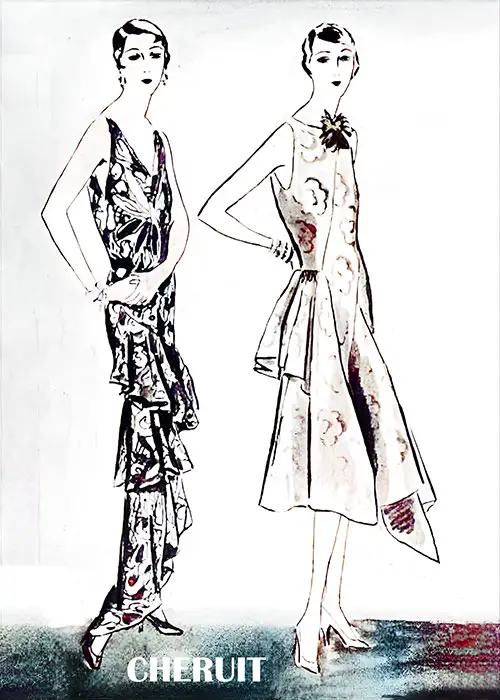
Skirt Interest: Chéruit model From Thurn and Chéruit model From Lord and Taylor. Vogue, 13 October 1928. | GGA Image ID # 217bcdfb9a
Skirt Interest
(Above Left) Viola Paris was captivated by the 'Danse Folie' dress, a stunning printed satin broché, for its unique one-sided line. The juxtaposition of a contemporary princesse silhouette with the unexpected placement of flounces gracefully descending to the floor is a masterclass in drapery.
(Above Right) The vibrant red satin broché dress, 'Dame de Coeur,' was handpicked by Viola Paris for its highly personal, sophisticated line. The panels and fullness harmonize with a princesse bodice. A deeper red carnation is delicately tucked in the high corsage, adding a personal touch.
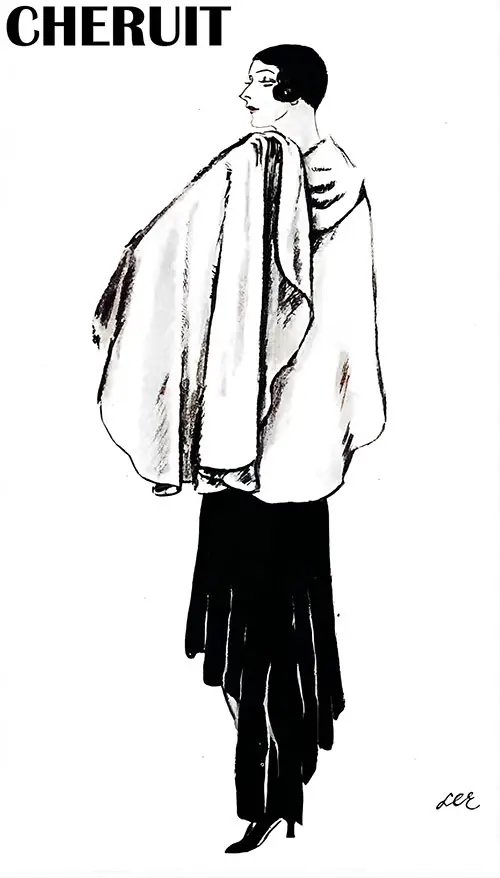
One of the Smartest Evening Wraps on the Riviera—the Cape Scarf—Is Characterized by Chic Nonchalance, an Air of Graceful Carelessness. Chéruit Fashions This One From the Softest Russian Ermine and Handles It so That It Has All the Suppleness, Gentle Pliancy, and Grace of a Silk Fabric. Vogue, 22 December 1928. | GGA Image ID # 217c2cbf8b
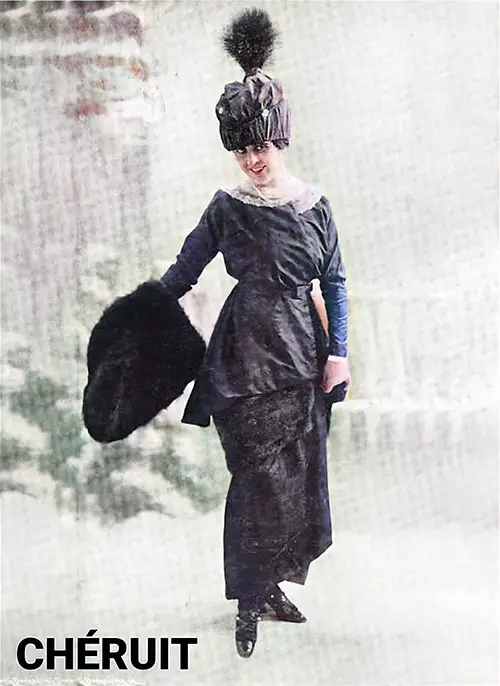
Robe d'après-midi, par Chérut. Photo par Talbet. Le Petit Mois Supplément illustré de la Revue des Français, 25 January 1912. | GGA Image ID # 2186b5b909
Robe d'après-midi, par Chérut.
La mode évolue. Son histoire enregistre rarement une véritable innova- tion, elle ne consacre qu’une fois en dix ans un modèle qui ne doive rien aux précédents. La "robe à paniers" que vient de lancer M’e Chéruit est une authentique nouveauté. Elle fait fureur dans le monde le plus chic. Déjà, on l’imite, sans vergogne. Mais pas tou- jours avec adresse.
Rien du XVe ou du XVI- siècle dans cette conception charmante, sinon la grâce un peu "Manon Lescaut."
Voici le premier pas, définitif, vers la robe ample. Pourtant le bas est étroit. Ce modele est en taffetas marron, lé- gèrement strié de noir avec col d’Alen çon et large bande de rat bleu.
(Translation of the French for the Afternoon Robe by CHÉRUIT)
Fashion evolves. Its history rarely records a true innovation; it only consecrates once in ten years a model that owes nothing to its predecessors. The "pannier dress" recently launched by Mme Chéruit is an authentic novelty. It is causing a sensation in the most fashionable circles. Already, it is being shamelessly imitated, but not always skillfully.
There is nothing from the 15th or 16th century in this charming design, except for a grace somewhat reminiscent of "Manon Lescaut."
Here is the first, definitive step towards the full dress. Yet, the bottom is narrow. This model is in brown taffeta, slightly striped with black, with an Alençon collar and a wide band of blue ratiné.
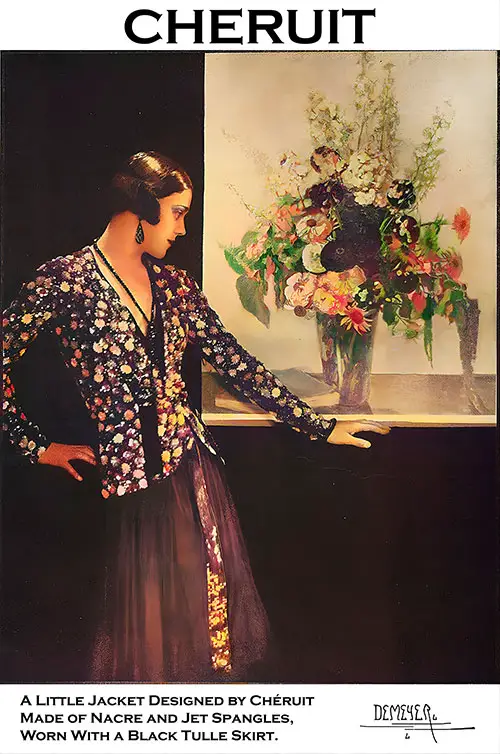
A Little Jacket Designed by Chéruit Made of Nacre and Jet Spangles, Worn With a Black Tulle Skirt. (Harper's Bazar, September 1929) | GGA Image ID # 226031c772
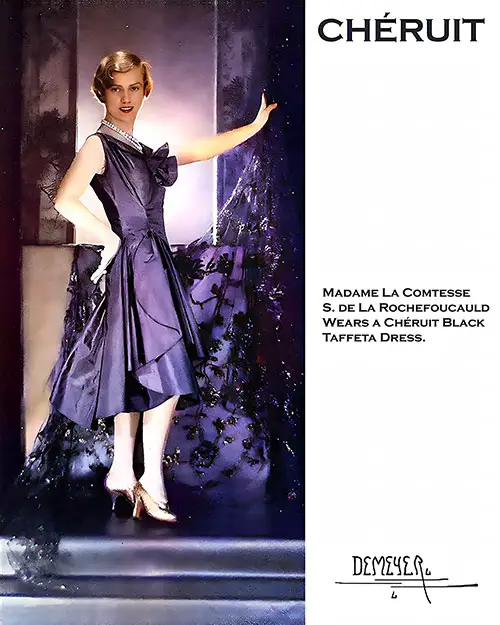
Madame La Comtesse S. de La Rochefoucauld Wears a Chéruit Black Taffeta Dress. Photo by De Meyer. (Harper's Bazar, October 1929) | GGA Image ID # 22634493ef
Winter 1930 Fashions by Chéruit
Chéruit's new winter collection stands out as one of the most unique in Paris, exuding Parisian chic with its distinct individuality. It's a refreshing departure from sports costumes, with Madame Wormser's 'trotteurs' and woolen clothes being referred to as 'shopping and traveling dresses.' Each piece is thoughtfully conceived and remarkably wearable, promising a collection that will captivate and inspire.
The Chéruit line for 1930 is rounded, curved, and entirely feminine in aspect (indications that seem to be heading straight toward the hourglass figure). This contrasts the work of other designers, who feature the long tube-like silhouette, leading the Mode towards the 'pre-war hobble', a style characterized by a narrow skirt that restricts the wearer's stride. Chéruit bodices follow the line of the typically built woman, the waistline being placed high up.
Day gowns are reasonably short, and two distinct types of dresses are shown. One is a short-waisted, full-skirted gown with a belt, and the other, called " La robe Princesse," has a clinging bodice molded to the figure and a bell-shaped skirt consisting of rounded panels. This kind of gown is presented in soft, supple, and printed velvet, and in several instances, short "culottes" (for comfort) are hidden beneath the skirt.
Chéruit evening gowns are famous worldwide. At times, they are pretty daring. They are an expression of modern colour schemes. Here are some color notes jotted down whilst visiting No. 23 Place Vendome: Novel chiffon scarves in two contrasting tones, neither of them matching the frock in the shade.
Sashes of colored ribbons, with ends reaching to the floor. On a yellow satin gown, nasturtium tones, with mauve, Blue, pink, and yellow on brown. Green and orange on pale Blue. An almost high-necked, long-sleeved evening gown in raspberry-red velvet, the shape of a 'redingote,' the entire dress is lined in liquid gold. This luxurious detail adds a touch of opulence to the design.
A buttercup-yellow moire gown, much fitted above with a tremendous flare below. A series of yellow pompons tumbled down the front of this gown; among them, a touch of bright jade-green.
Lovely is a rose-red velvet dress, quite daring because of its leaf-green sash. Daring! Yes, but oh! so beautifully new! Almost as original, a shiny, black net ballgown was trimmed with several cerise satin bows and by two pale green sash ends.
Wonderful and unique are the Chéruit capes. They flare, undulate, and are inimitable. No one can copy them.
The most beautiful of all is a monumental affair of crisp black faille and ciré satin—a ship in full sail. Another shiny gold cloth has rounded panels, like angels' wings. A gorgeous Venetian red velvet cape lined with burnished gold. And yet another, a flowered brocade, resembles a flower garden.
Bibliography
"Chez Madame CHÉRUIT" in Le Petit Mois Supplément illustré de la Revue des Français, 25 January 1912.
"Chéruit" in the Garment Manufacturers' Index, New York: The Allen-Nugent Co. Publishers, Vol. II, No. 3, October 1920: 22. Image from The Delineator, June 1919: 87.
"A Yachtswoman Is Interviewed About Correct Clothes and Colors for Wear Aboard Ship," in Fairchild's International Magazine, London-Berlin-Vienna-New York: Publications Fairchild, S.A., Vol. 4, No. 1, August 1928, pp. 24-25.
Baron de Meyer, "Winter Fashions for 1930: A Century After the 1830 Period: Chéruit, in Harper's Bazar, October 1929, p. 74.
🌟 Why This Article Stands Out
Chéruit's artistry was rooted in the mastery of drapery, precision tailoring, and a keen awareness of the modern woman’s needs—whether she was attending a Parisian soirée, sailing across the Atlantic, or lounging aboard a luxury yacht.
This article captures:
📐 The technical innovation of her paneling, pleating, and silhouette manipulation.
🌈 Bold color choices and material experimentation like arsenic green, velours de laine, and duvetyn.
👒 The maritime fashion influence, as shown in her collaborations with iconic yachtswoman Madame Virginie Hériot.
✨ A wealth of rare archival images and original descriptions from Harper’s Bazar, Vogue, and The Delineator, giving readers a front-row seat to prewar and interwar Parisian fashion.
📸 Noteworthy Images
🖼️ Harem Hem Chemise Dress (1919)
A Persian-inspired crêpe creation loops into a harem-style hem—elegant, modern, and adaptable for leisure cruising or promenades aboard ship.
🖼️ Warm Brown Duvetyn Suit with Skunk Trim (1913)
The box-pleated fullness and godet details exemplify how structure met softness—a perfect ensemble for stylish transatlantic travel.
🖼️ Evening Gown in Purple Velvet
With panniers, crystal bead trim, and a veiled neckline, this gown epitomizes Chéruit’s ability to fuse luxury with restrained romanticism.
🖼️ Yachting-Inspired Outfits by Chéruit (1928)
As worn by Madame Hériot, these functional yet feminine ensembles reflect fashion’s response to the expanding role of elite women in sports and travel. White suede sandals with red rubber soles? Yes, please!
🖼️ Riviera Evening Wraps (1928)
A Russian ermine cape-scarf fashioned like silk proves that utility and opulence can co-exist beautifully in seaside fashion.
📚 Relevance for Education & Research
🔍 For Teachers & Students
This article offers a primary-source-rich springboard for lessons on:
The evolution of women’s roles through fashion
The dialogue between French couture and British/American consumers
Fashion’s role in social class and global mobility
🧬 For Genealogists
Chéruit’s styles can help identify attire in old family photographs from ocean liner voyages, weddings, and portraits, particularly between 1905–1930.
🎓 For Fashion Historians
The article showcases the emergence of modern fashion marketing, the rise of haute couture as a cultural export, and the art of wearable luxury.
🛳️ For Ocean Travel Scholars
With clear references to travel wardrobes, maritime fashion functionality, and elite seafaring clients, this is a rare fashion-centric angle on liner culture.
🧾 Mini-Dictionary of Terms
Charmeuse: A lightweight, soft, satin-finish silk often used for evening gowns.
Ciré satin: Satin fabric treated with a glossy, waxed finish.
Culottes: Divided skirts or under-shorts for comfort, often hidden under dresses.
Duvetyn: A soft, smooth woolen fabric with a short nap, ideal for autumn/winter garments.
Faille: A ribbed silk or synthetic fabric with a structured drape.
Godet pleats: Triangle-shaped insets that add flare to skirts or coats.
Guimpe: A high-necked inset worn under a low-cut dress.
Panneaux évasés: Flared fabric panels, often set in for movement or decorative fullness.
Plastron: A wide front panel on a bodice, often highly decorative.
Velours de laine: Wool velvet; a heavier, warmer luxury fabric used in outerwear.
📚 How to Cite This Page
Chicago Style
Footnote:
Gjenvick-Gjønvik Archives, “Louise Chéruit: Parisian Fashion, Yachting Style, and Couture at Sea (1905–1930),” GG Archives, accessed Month Day, Year, https://www.ggarchives.com/OceanTravel/Fashions/FashionHouses/Cheruit-TimelessEleganceFashionAtSeaAndAshore.html.
Bibliography:
Gjenvick-Gjønvik Archives. “Louise Chéruit: Parisian Fashion, Yachting Style, and Couture at Sea (1905–1930).” GG Archives. Accessed Month Day, Year. https://www.ggarchives.com/OceanTravel/Fashions/FashionHouses/Cheruit-TimelessEleganceFashionAtSeaAndAshore.html.
APA Style
Gjenvick-Gjønvik Archives. (1905–1930). Louise Chéruit: Parisian Fashion, Yachting Style, and Couture at Sea. GG Archives. Retrieved Month Day, Year, from https://www.ggarchives.com/OceanTravel/Fashions/FashionHouses/Cheruit-TimelessEleganceFashionAtSeaAndAshore.html
MLA Style
Gjenvick-Gjønvik Archives. “Louise Chéruit: Parisian Fashion, Yachting Style, and Couture at Sea (1905–1930).” GG Archives, 1905–1930. Web. Accessed Day Month Year. https://www.ggarchives.com/OceanTravel/Fashions/FashionHouses/Cheruit-TimelessEleganceFashionAtSeaAndAshore.html
✍️ Final Thoughts for Readers
Students and educators are strongly encouraged to use this article as a primary source for essays or research into early 20th-century fashion, women’s history, or transatlantic cultural exchange. With original images, rare archival notes, and historical context, this feature from GG Archives is more than a fashion retrospective—it’s a portrait of modern femininity on the move. 🌍✈️🛳️
No blog comments necessary—just bring your curiosity, your notebook, and your imagination. 📖🖋️✨
